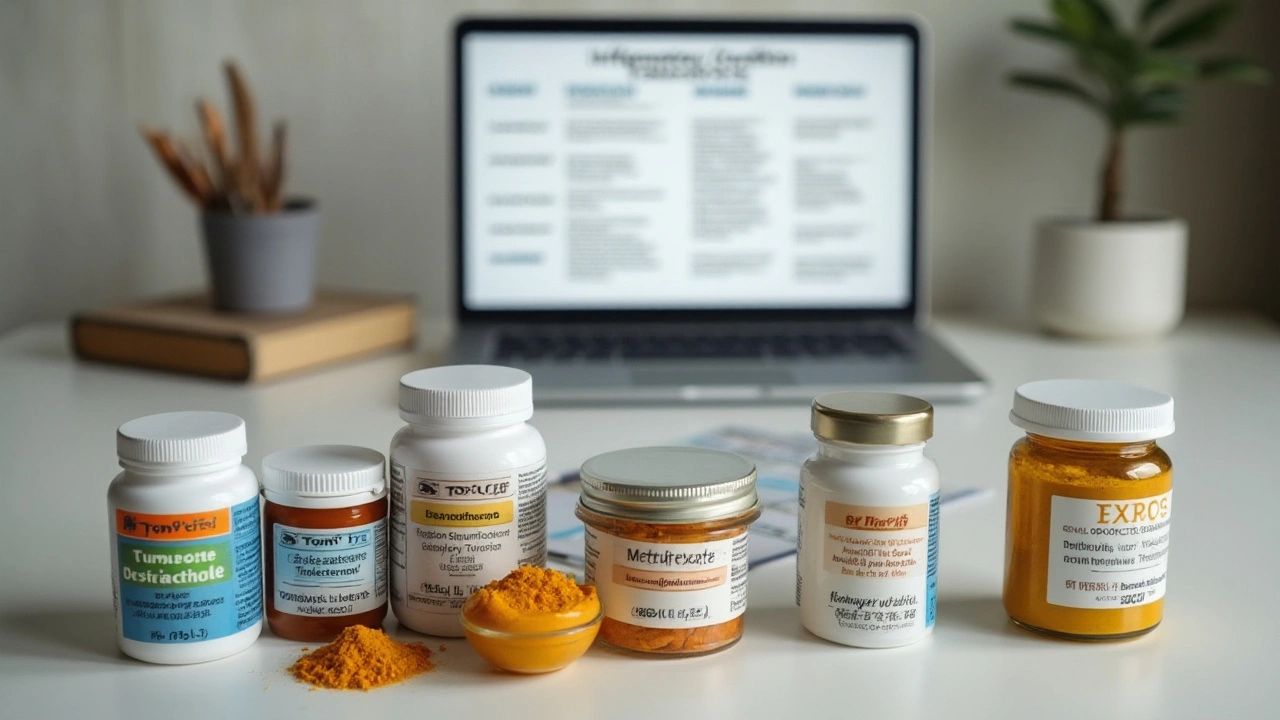Navigating the world of medications can be a maze, especially when trying to manage inflammatory conditions. Prelone, a well-known corticosteroid, has served many in their fight against inflammation, but it's not always the perfect fit for everyone. This year, a range of alternatives has emerged, offering different approaches to treatment with their own sets of benefits and considerations.
The story doesn't end with synthetic compounds; nature also plays a starring role with options like turmeric making a splash. While the effectiveness of each alternative varies based on the condition and individual response, this guide offers a detailed dive into potential substitutes for Prelone. Whether you're looking for a more potent option or seeking fewer side effects, there's likely an alternative worth considering. Join us as we explore nine noteworthy contenders in the evolving landscape of inflammatory treatments.
- Dexamethasone
- Methotrexate
- Mycophenolate
- Mercaptopurine
- Azathioprine
- Leflunomide
- Turmeric
- Bioavailable Curcuma
- PEA
- Conclusion
Dexamethasone
Dexamethasone is a powerhouse when it comes to managing inflammation and is highly regarded in medical circles for its efficacy. As a corticosteroid, it is often called upon to tackle stubborn inflammatory conditions that other medications may struggle to control. A standout feature of dexamethasone is its potency compared to many corticosteroids, including prednisone. This means it can be used in lower doses which often translates to fewer side effects—a benefit not to be underestimated. Its longer duration of action also contributes to its popularity, requiring less frequent dosing, which can be a huge convenience for patients.
The reach of dexamethasone extends across various medical conditions. It has shown remarkable effectiveness in acute asthma management, helping to alleviate symptoms swiftly when breathtaking reactions are at their peak. In hospital settings, it is a staple in reducing inflammation for patients with severe allergic reactions. Its clinical applications even venture into oncology, where it's used to minimize inflammation related to tumor burden. While there is a possibility of side effects typical of corticosteroids, such effects tend to occur less frequently given the judicious use of doses. A quote from a medical expert in a 2022 Journal of Clinical Medicine states,
"Dexamethasone's efficacy in reducing inflammation and stabilizing patient conditions in acute scenarios has been vital, making it an integral part of emergency response protocols."
Physicians have long praised dexamethasone's ability to offer relief without the hassle of constant monitoring. Unlike other medications that require constant administration due to short half-lives, dexamethasone remains effective for longer periods, freeing patients from the shackles of around-the-clock dosing schedules. For individuals dealing with chronic inflammation, this feature can profoundly impact their daily lives, allowing them to focus on routine activities without being preoccupied with medication schedules. One should, however, always ensure to balance the benefits and understand potential long-term risks, such as bone density loss or adrenal suppression, which require monitoring during extended usage.
Moreover, dexamethasone's role during the COVID-19 pandemic as a treatment option for inflammation has brought it back into the public eye, championing its status as a critical tool within the medical arsenal. A study published in the New England Journal of Medicine showed significant improvements in outcomes for patients receiving dexamethasone, particularly those requiring respiratory support. This finding underlined its capacity not only as a routine treatment but also as a vital part of emergency and critical care responses. Its versatility across a range of applications continues to illustrate just why this medication remains relevant and essential.
For anyone considering switching to dexamethasone as a Prelone alternative, it is essential to engage with healthcare providers to tailor the medication plan to individual needs, weighing the potential benefits against the necessity for lifestyle adaptations due to side effects. With careful management, dexamethasone can indeed be a robust option, offering relief and stabilization where inflammation lurks, and its benefits often span beyond just the treatment of disease.
Methotrexate
Methotrexate is a versatile player in the world of disease-modifying antirheumatic drugs, commonly known as DMARDs. It’s primarily employed in the fight against autoimmune conditions like rheumatoid arthritis and lupus. What sets Methotrexate apart is its dual action; it not only helps manage symptoms but also targets the underlying inflammation that contributes to disease progression. This means that for many, it's more than a mere band-aid solution; it offers a real shot at long-term improvement in quality of life. While originally introduced as a treatment for cancer back in the 1940s, today, Methotrexate is softened into lower doses, making it more manageable for chronic conditions. Such a transition illustrates the drug's potential and adaptability in medicine over time. However, one should never take it lightly, as its usage does require careful monitoring.
In terms of administration, Methotrexate can be taken orally or injected, which offers flexibility depending on patient needs and responses. A standout quality is its ability to reduce reliance on corticosteroids like Prelone, thus alleviating the burden of steroid-related side effects. What is fascinating about Methotrexate is how it interrupts the methionine metabolism in rapidly dividing cells, reducing their multiplication and therefore easing inflammation. As a result, users often notice decreased joint swelling and pain within weeks, although the full effect may take months to manifest. This feature adds a layer of patience to its application, making continuous follow-ups with healthcare providers crucial.
Even with all its benefits, Methotrexate is not without its cons. There’s an ongoing commitment required, as regular blood tests are crucial to monitor liver function and blood cell counts. The impact on the liver is one of the more serious considerations, making lifestyle adjustments—like limiting alcohol intake—part of the journey. Gastrointestinal distress can occur, drawing the need for dietary mindfulness to the forefront. Anecdotes from the field often highlight healthcare practitioners emphasizing the importance of supplements such as folic acid, which can offset some of the side effects. This balance of medication and supplementation showcases the intricacies involved in its use, underscoring the importance of individualized patient care.
"Methotrexate is a cornerstone in rheumatoid arthritis treatment, prized for its ability to slow disease progression and enhance life quality, but it requires vigilance due to potential side effects," notes the Arthritis Foundation.
Interestingly, a study published in the Journal of Rheumatology suggested that combination therapy—pairing Methotrexate with biologics—often results in symptom improvement that single-agent therapy struggles to achieve. This research fuels ongoing discussions among medical experts about optimizing treatment regimens for better results. Patients are encouraged to engage in these conversations, continuously exploring options that promise the most comfortable life with the least interference. The interplay between patient experience, evolving research, and clinical practice paints Methotrexate not just as a treatment option, but as a component of a larger stratagem in fighting chronic inflammation. This makes it a fascinating subject not only for those seeking relief but for the medical community committed to advancing therapeutic effectiveness.
Mycophenolate
In the spectrum of medications designed to combat autoimmune diseases, Mycophenolate stands out as a significant player. Primarily used for conditions such as lupus and certain types of vasculitis, Mycophenolate has been instrumental in reducing the dependency on steroids like Prelone. This is crucial for many patients, as long-term steroid use often brings a raft of undesired effects. What's particularly interesting about Mycophenolate is its initial development for organ transplant patients to protect against rejection. This highlights its impressive capability in moderating immune system activity. With its success in organ transplants, its application broadened to other autoimmune conditions, demonstrating versatility and efficacy.
As with any medication, its benefits are accompanied by potential side effects. Users may experience gastrointestinal discomfort, which can be managed with the correct dietary adjustments and consultation with healthcare providers. The drug also necessitates regular monitoring of blood counts due to its bone marrow suppressive capabilities, a common occurrence with many immunosuppressants. Given its suppressive actions on the immune system, there's a heightened vigilance required for infections. Yet, despite these considerations, many find the trade-off beneficial for the stability and control Mycophenolate offers in their therapy plan.
"Mycophenolate is certainly a valuable tool in treating autoimmune conditions where other medications fall short. Its ability to reduce steroid reliance significantly impacts patient's long-term quality of life." – Dr. Elizabeth Ballew, Rheumatologist
There are several factors determining if Mycophenolate is right for a patient. Physicians evaluate the severity of the condition, past responses to treatments, and personal health history in deciding suitability. It's this personalized evaluation that often leads to its inclusion in treatment plans tailored to individual needs. Importantly, the coordination between patient and health provider is key to maximizing Mycophenolate's benefits. Patients are encouraged to maintain an open dialogue about their experiences and concerns, ensuring the optimal use of this therapeutic option. This collaboration lays the foundation for achieving desired health outcomes and maintaining well-being in the journey through autoimmune challenges.

Mercaptopurine
Mercaptopurine emerges as a pivotal player in the realm of treatments for inflammatory conditions, particularly those affecting the gut such as inflammatory bowel disease (IBD). Recognized primarily as an immunosuppressant, mercaptopurine works by tempering the body's immune response, which is often the underlying cause of inflammation in conditions like Crohn's disease and ulcerative colitis. This medication reduces the need for corticosteroids like Prelone by managing inflammation directly, making it an appealing choice for many. The mechanism of mercaptopurine is fascinating; it inhibits the synthesis of purine, a vital component of DNA, which in turn reduces the proliferation of cells involved in the inflammatory response. This effectiveness not only helps in controlling disease flare-ups but also aids in maintaining remission, offering patients a semblance of normalcy. A balanced treatment plan often involves a combination of dietary management and medication such as mercaptopurine, which underscores the importance of collaboration between healthcare providers and patients to tailor treatments to individual needs.
One notable aspect of mercaptopurine is its dual role in both induction and maintenance of remission. Because of this versatility, it is often prescribed alongside other therapies to provide a comprehensive approach to managing IBD. However, it is not all sunshine and rainbows. Patients should be aware of the potential side effects, which include bone marrow suppression and the risk of infections due to decreased white blood cell counts. Regular blood tests are typically required to monitor blood cell levels during treatment, emphasizing the need for attentive medical supervision. Despite its potential drawbacks, many patients experience significant relief with mercaptopurine, reporting fewer hospital visits and improved quality of life. Interestingly, a study published in the Journal of Gastroenterology noted that up to 70% of IBD patients showed substantial improvement with mercaptopurine use over a two-year period, highlighting its efficacy.
For those concerned about the long-term implications of immunosuppressive therapy, it's worth noting that mercaptopurine has been used in clinical practice for decades, providing substantial data on its long-term safety and effectiveness. As with any medication, especially those used as alternatives to Prelone, patient education and involvement in treatment decisions is crucial. Understanding the balance between benefits and risks can empower patients to engage actively with their healthcare journeys. The story of mercaptopurine is a testament to the intricate dance between innovation and tradition in medicine, striving to offer solutions that not only treat but respect the complexities of the human body. It's an example of how old-school medications continue to make waves, adapting to the evolving understanding of diseases and their management.
Azathioprine
Azathioprine, an immunosuppressive medication, is often a crucial player in the toolkit for treating various autoimmune conditions. Developed initially in the 1960s, it has stood the test of time in part due to its broad-ranging applications and effectiveness. Primarily, it's used for diseases like lupus, rheumatoid arthritis, and even in organ transplant cases to prevent rejection. What makes Azathioprine stand out is its ability to tamp down the body’s immune response, curbing the inflammation that characterizes these chronic conditions. Doctors have relied on it to help patients reduce their dependence on corticosteroids like Prelone, offering a path to fewer side effects without sacrificing therapeutic efficacy.
Despite its benefits, Azathioprine doesn’t come without strings attached. For one, it can cause bone marrow suppression, which is a serious condition where the body can't produce enough blood cells. This makes regular blood tests a part of the routine when you're on this medication. Liver toxicity is another concern, making it important for patients to regularly monitor their liver function. Not to mention the increased susceptibility to infections, given the immune system's reduced ability to fight off invaders. But despite these potential drawbacks, Azathioprine remains a staple, especially since its benefits often outweigh its risks when used properly.
"Azathioprine is a critical part of our therapeutic arsenal for autoimmune diseases. It allows us to strategically reduce inflammation without heavy reliance on steroids," says Dr. Emily Sanchez, a rheumatologist with over two decades of experience.
Cost is another factor where Azathioprine shines. Known for being a cost-effective alternative, it's often available as a generic drug, which alleviates the burden on patients who might otherwise fold under the weight of expensive medications. This affordability does not diminish its effectiveness, as evidenced by countless studies demonstrating its capacity to manage symptoms effectively. Awareness, therefore, becomes key in understanding how Azathioprine, with its low cost, can open doors for many who suffer from debilitating conditions.
It's worth noting that Azathioprine’s role in treatment protocols is often a balancing act. Physicians need to carefully calculate the right dosage to maximize benefits while minimizing risks. This delicate dance means it often plays second fiddle to more aggressive steroids in the initial phase of treatment, moving up in prominence as patients achieve a stable condition. Azathioprine is a tried and tested solution, providing a viable alternative for those seeking to lessen the burden of corticosteroids like Prelone.
Leflunomide
Leflunomide, known to many as a powerful player in the realm of rheumatoid arthritis treatment, provides a beacon of hope for those managing chronic inflammatory conditions. This disease-modifying antirheumatic drug (DMARD) has carved its niche due to its remarkable ability to reduce reliance on corticosteroids like Prelone. It achieves this by interfering with the proliferation of inflammatory cells, offering much-needed relief without the extensive side effects often associated with steroids. Slowing down the disease's progression, Leflunomide not only aids with symptom relief but plays a pivotal role in preserving joint function and mobility.
The action of Leflunomide is due to its impact on an enzyme called dihydroorotate dehydrogenase, which is crucial for the synthesis of pyrimidines. By disrupting this pathway, the drug effectively hinders the growth of rapidly dividing cells, typical in inflammatory conditions. This mechanism might sound intricate, but the effects are beautifully simple when experienced. Patients frequently report less joint swelling and reduced morning stiffness, creating a profound improvement in daily living. As a result, Leflunomide stands tall in the medical community, often recommended for those not tolerating other treatments well.
Like every medication, Leflunomide is not without its share of concerns. Liver toxicity can be a risk, especially when used over extended periods or in conjunction with other hepatotoxic drugs. Regular monitoring through blood tests becomes imperative, ensuring liver function remains uncompromised. Additionally, the drug's potential to lower immune defenses leads to an increased susceptibility to infections. This risk highlights the importance of diligent personal health practices while undergoing treatment. Patients must engage with their healthcare providers actively, discussing any unusual symptoms that may arise, however minor they might seem.
Leflunomide has been a cornerstone in rheumatoid arthritis management since its introduction. The well-documented benefits provide life-altering changes for those who respond well.
Statistics and clinical studies have repeatedly shown that Leflunomide can effectively decrease the disease activity score in patients. In the complex landscape of inflammatory treatments, choices abound, but Leflunomide garners trust due to its balance between efficacy and manageable side effects. It's often prescribed as part of a combination therapy, amplifying its impact when paired thoughtfully with other treatments. This tailored approach allows for individualized treatment plans, making the control of inflammation a personalized journey rather than a generic one.

Turmeric
Turmeric, the golden-hued spice that likely sits in your kitchen cabinet, has found its way into modern medicine thanks to its powerful anti-inflammatory properties. This vibrant spice, long celebrated in Ayurvedic and Chinese healing traditions, is now being eyed as a promising alternative to Prelone for managing inflammatory conditions. The secret ingredient in turmeric is curcumin, a compound that boasts strong potential for alleviating inflammation and pain. Curcumin is the star of the show here, offering a natural answer to ailments without the side effects often associated with synthetic drugs.
Traditionally used for its dye and flavor, turmeric has recently been the subject of intense scientific scrutiny, and for good reason. It's been shown to improve joint health, making it a staple in treating arthritis and similar disorders. Daily doses of turmeric may not only help manage pain but also contribute to long-term health by continuing to ease chronic inflammation. However, one challenge with turmeric and curcumin is their low bioavailability, which means the body's capacity to absorb these compounds efficiently is limited. Introducing black pepper or oils into your meals alongside turmeric can significantly boost curcumin absorption, making those pursuing natural options more likely to consider it as an alternative treatment.
As more people turn to natural remedies, turmeric's popularity continues to bloom. Many now reach for supplements that encapsulate its benefits in a convenient pill form. According to a review by the National Institutes of Health, curcumin could significantly reduce pain and swelling, particularly in patients with arthritis. Yet, with such glowing endorsements come caveats. Some users might find that they need to take higher doses to achieve desired results, which demands consulting with healthcare professionals to ensure it’s safe within personal health profiles.
Incorporating turmeric into your diet can be as easy as sprinkling it on salads, blending it into smoothies, or even stirring it into your morning scrambled eggs. For those who are looking into the future of their health, understanding how to utilize turmeric properly is crucial. Evidence continues to mount in favor of turmeric as a potential tool in the arthritis treatment kit, bolstering its credibility as a supplemental aid alongside traditional medicine. But, as we explore the myriad capabilities of turmeric, it's essential to find the right balance in its usage.
"Curcumin has shown antioxidant, anti-inflammatory, antiviral, and anticancer properties," notes a comprehensive survey published by the NIH. This highlights the spice's ability to act as a versatile ally in combating a variety of health concerns.
Before stocking up on turmeric supplements, it’s wise to consider the quality of the supplement brand, potential reactions with existing medications, and whether turmeric suits your specific inflammatory condition. Each individual metabolizes supplements differently, thus emphasizing the importance of personalizing any treatment approach. As it stands, turmeric appears to be a tangible alternative for those considering moving away from Prelone, offering a natural path with promising outcomes. With every new study released supporting turmeric's efficacy, this golden spice continues to shine brightly in the realm of health and wellness.
Bioavailable Curcuma
The vibrant yellow spice known commonly as turmeric has been a feature in kitchens and medicine cabinets for centuries. Its primary active ingredient, curcumin, boasts impressive anti-inflammatory properties. Turmeric alone doesn't easily absorb into the body, which means its healing potential is limited unless enhanced. That's where Bioavailable Curcuma steps in, as a game-changer in making curcumin more accessible to the body's systems. This form of curcuma is specially formulated to increase absorption, ensuring that the body gets more of the beneficial compounds it needs to fight inflammation.
Many studies highlight its potential. For instance, researchers have found that when curcumin is combined with certain substances like piperine (found in black pepper), its bioavailability can increase by as much as 2000%. This transformation opens up new avenues for people seeking a natural alternative to synthetic steroids like Prelone. The mechanism here is simple: enhanced absorption means that the body can more effectively utilize curcumin's pain-relieving and anti-inflammatory benefits, making it a viable option for managing conditions like arthritis and chronic pain.
A growing body of evidence supports its benefits. It's not just about what's happening at the molecular level; real-world outcomes matter too. Patients report noticeable improvements in joint pain and stiffness, with fewer concerns about the typical side effects associated with long-term steroid use. As an ingredient, bioavailable curcuma is still subject to variability in terms of quality and efficacy across different brands. It requires diligence from the consumer to select products from reputable manufacturers. The increased popularity of this potent form of curcumin has also seen it integrated across a range of supplements and health foods, making it easier than ever before for people to incorporate into their daily routines.
Bioavailable Curcuma is celebrated not only for its increased absorption but also due to its versatility. It's a component that can be seamlessly added to various therapies, presenting minimal interaction with other medications, which is not always the case with more traditional drugs. The naturally-derived nature of curcumin means it aligns well with holistic health approaches often favored by those wary of synthetic drugs. There's a growing trend towards natural remedies, and curcumin is right at the forefront, championing the notion that sometimes the best medicine comes from nature itself.
The narrative surrounding Bioavailable Curcuma is one of balance — providing relief without the harsh consequences. This approach aligns well with a lifestyle-focused on mindfulness and treating the body gently. A typical consultation with a healthcare provider could now routinely include discussions about curcumin supplements, especially as its reputation for effectiveness continues to grow. Although it's crucial to approach all new treatments with informed caution, bioavailable curcuma offers much promise, particularly for those who prioritize natural treatments and wish to complement their existing medication regimens.
"Curcumin is remarkably safe and evidence shows it offers potential benefits for a range of inflammatory diseases," says Dr. Andrew Weil, a respected physician in integrative medicine, underscoring the growing consensus in the medical community.
Palmitoylethanolamide (PEA)
Palmitoylethanolamide, often abbreviated as PEA, is a naturally occurring compound that has been thrust into the spotlight due to its intriguing potential to alleviate inflammation and pain. Despite its tongue-twister name, PEA is primarily known for its presence in the human body where it functions as a natural analgesic and anti-inflammatory agent. Found in foods like egg yolks and peanuts, PEA's endogenous role is to modulate the body's response to inflammation, providing intriguing possibilities for those looking to reduce dependency on traditional corticosteroids like Prelone.
What makes PEA particularly appealing is its holistic approach to managing chronic pain and inflammation. Since it is identical to what your body already produces, the prospect of PEA being well-tolerated combines efficacy with safety. Studies have indicated that PEA can significantly contribute to pain reduction and provide a natural alternative to more invasive treatments. One of the remarkable aspects of PEA is its ability to coexist with other medications, offering the potential to enhance or replace inflammatory treatments. An article published in the Journal of Pain Research noted, "PEA has an excellent safety profile, making it a promising agent for long-term treatment." This endorsement has spurred growing interest in its application across various medical fields, from neuropathic pain to inflammation.
Of course, while there are exciting possibilities, PEA is still climbing the ladder of scientific validation. Most trials highlight its safety, but larger-scale studies are poised to solidify its standing. One caveat is that it might not pack the same immediate punch as synthetic medications in cases of severe inflammation, a factor worth considering for those undergoing intense treatment regimens. However, its natural origins and minimal side effects might outshine its limitations, positioning it as a trusted ally in health management. As with any supplement, discussions with healthcare providers remain crucial, ensuring that PEA fits comfortably within a comprehensive health strategy.

Conclusion
In the search for effective treatments for inflammatory conditions, the alternatives to Prelone we have explored offer a diverse spectrum of options, each with its own strengths and challenges. From potent corticosteroids like Dexamethasone to natural solutions such as Turmeric, these alternatives present varied pathways to managing inflammation with reduced side effects or specific clinical benefits. The journey to finding the right treatment is often about balancing efficacy with tolerability, an endeavor that requires careful consideration and sometimes lengthy discussions with healthcare providers.
Dexamethasone stands out for its potency and prolonged action, which might mean fewer doses and a better side effect profile for certain conditions. Meanwhile, Methotrexate serves as a vital player in the realm of autoimmune disorders, helping manage conditions like lupus effectively alongside or in place of corticosteroids. Then there's Mycophenolate, offering complementary benefits in reducing the steroid burden while also promising a wider range of therapeutic applications across autoimmune diseases. Such considerations are crucial when the goal is to not only treat the condition but also enhance the patient's overall quality of life.
For those exploring options outside of the synthetic spectrum, natural alternatives like Turmeric with its rich anti-inflammatory properties can appeal. While it may not match the potency of its pharmaceutical counterparts, the reduction in potential side effects offers a significant advantage. Palmitoylethanolamide (PEA), another natural compound, provides an interesting option for patients, particularly those dealing with chronic pain and allergies, though, like many natural alternatives, more research is needed to fully understand its place in treatment regimens.
"The use of natural compounds in modern medicine is gaining traction, not as replacements but as valuable parts of integrative treatment strategies," notes a report from the Global Inflammatory Disease Foundation.
Each alternative brings something unique to the table, ensuring that patients have choices that can be tailored to their specific needs. Whether the focus is on reducing steroid dependency with DMARDs like Leflunomide or exploring bioavailable forms of natural compounds, the flexibility to pivot and adapt the treatment plan cannot be overstated.
To help visualize and compare these alternatives, consider the table below which summarizes their key attributes:
| Alternative | Role | Pros | Cons |
|---|---|---|---|
| Dexamethasone | Corticosteroid | Long-acting, fewer side effects | Similar long-term risks as steroids |
| Methotrexate | DMARD | Reduces steroid need | Gastrointestinal side effects |
| Mycophenolate | DMARD | Effective in autoimmune conditions | Risk of infections |
| Turmeric | Natural Anti-inflammatory | Few side effects | Variable absorption |
Understanding these options in detail allows for more informed choices about one's healthcare journey. Communicating regularly with medical professionals ensures that decisions are well-supported by clinical evidence and tailored to the individual's evolving needs. The landscape of Prelone alternatives thus offers not just medications, but a range of strategies to manage health conditions efficiently and with care.






Kaylee Crosby
October 25, 2024 AT 17:38I've been on methotrexate for 3 years now and honestly it changed my life. No more daily prednisone crashes, no more moon face, no more insomnia. Yeah, I get a little nausea sometimes but folic acid fixes that. My joints don't feel like they're full of gravel anymore. Just give it time, it's not magic on day one but after 8 weeks? Total game changer.
Also, drink water. Like, a lot. Your liver will thank you.
Adesokan Ayodeji
October 26, 2024 AT 21:10Man, this post is a goldmine! I'm from Nigeria and we don't always have access to fancy meds like dexamethasone or methotrexate, so I've been using turmeric with black pepper and coconut oil for my arthritis for over 2 years now. It's not as strong as steroids but it's cheap, safe, and I don't feel like I'm being poisoned by my own medicine.
My cousin in Lagos tried bioavailable curcuma and said the difference is night and day - he used to need a cane, now he walks to market every morning. The science behind absorption is real, folks. Don't just buy any turmeric powder - look for ones with piperine or liposomal delivery. I've even started growing my own turmeric in pots!
And PEA? I read about it on a forum last year and ordered some online. It's not a miracle but it helps with the nighttime pain when everything else is quiet. I combine it with gentle yoga and warm baths. Medicine doesn't always have to come in a pill bottle. Sometimes it comes from your kitchen, your patience, and your willingness to try.
Karen Ryan
October 28, 2024 AT 14:30PEA is underrated 😍 I tried it after my rheumatologist said I could ‘experiment’ with it. No liver checks, no blood draws, no scary side effects. Just… less pain. Like, my knee stopped screaming at night. I take 600mg twice a day.
Also - if you’re on azathioprine, PLEASE get your TPMT tested. My friend had a near-death experience because they didn’t. Don’t be that person. ❤️
Terry Bell
October 28, 2024 AT 15:25It's funny how we're so quick to trust a chemical compound made in a lab but skeptical of something that's been healing people for 5,000 years. Turmeric isn't a 'natural alternative' - it's the original medicine. The body doesn't see curcumin as foreign. It sees it as a signal, a whisper to calm down. Steroids? They're like a sledgehammer to a mosquito. They shut everything down, including your immune system's ability to tell friend from foe.
That's why I think the real breakthrough isn't just bioavailable curcuma or PEA - it's the shift in mindset. We're not just treating inflammation, we're listening to our bodies again. And maybe that's the most powerful medicine of all.
Also, methotrexate and folic acid? That's not a combo, that's a love story. Folic acid is the quiet hero holding the line while methotrexate does the heavy lifting. Respect the duo.
Lawrence Zawahri
October 29, 2024 AT 06:08EVERY SINGLE ONE OF THESE 'ALTERNATIVES' IS A BIG PHARMA TRAP.
Dexamethasone? They used it in COVID to kill people quietly. Methotrexate? It was originally a CHEMOTHERAPY DRUG. Mycophenolate? Developed by the same people who made the anthrax vaccine.
And turmeric? HA. They patent the 'bioavailable' version so you pay $50 for something that grows in your backyard. They don't want you healing naturally. They want you addicted to pills.
PEA? Sounds like a chemical code. Probably made in a lab in Switzerland.
STOP TRUSTING DOCTORS. STOP TRUSTING PHARMA. EAT REAL FOOD. SLEEP. MOVE. BREATHE. THAT'S THE ONLY REAL 'ALTERNATIVE' THAT MATTERS.
They're selling you hope wrapped in a prescription. I've seen it. I know how it works.
Benjamin Gundermann
October 31, 2024 AT 03:46Bro I read this whole thing and honestly I'm just confused why anyone would take all these fancy pills when you can just eat like a normal human.
Like I used to take azathioprine for my Crohn's, but then I just stopped eating processed junk, started drinking bone broth, and ate a ton of fermented stuff. Guess what? My flares dropped 90%. No blood tests. No side effects. No doctor telling me to 'monitor my liver.'
And don't get me started on turmeric supplements - you know what's cheaper? Just buy a big bag of the spice, mix it with olive oil and pepper, and put it on eggs. Boom. Natural. Free. Real.
Why are we letting Big Pharma convince us that our bodies can't heal unless we pay $200 a month for a pill that came from a lab in Germany? We used to survive without all this. We can again.
Also, PEA? Sounds like a new energy drink. I'm out.